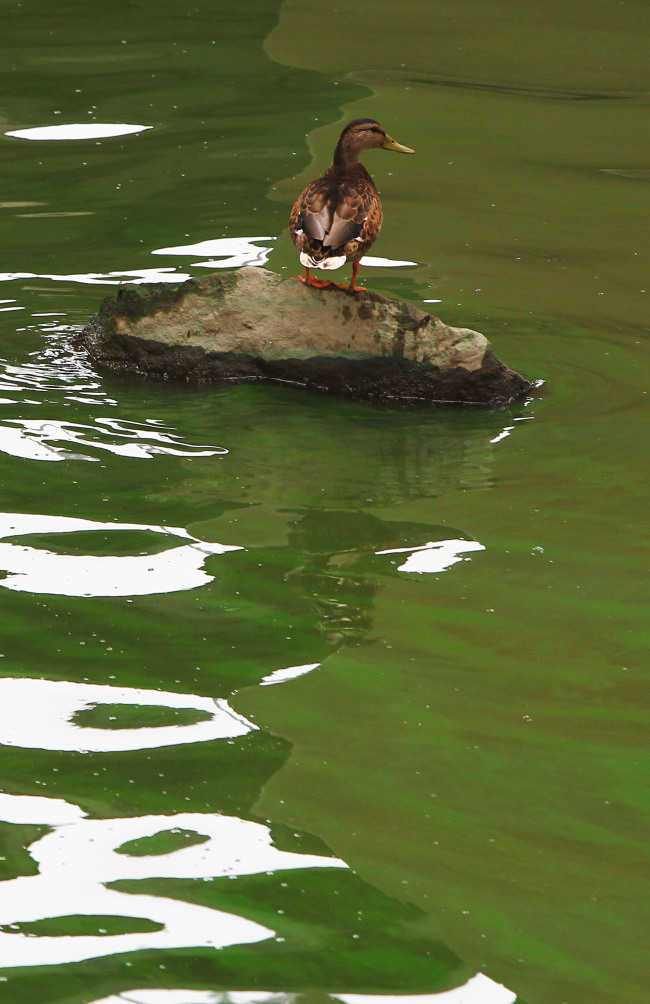Seoul says algae in Han River poses no health threat
By Kim Young-wonPublished : Aug. 10, 2012 - 20:19
As public concerns grew over the safety of tap water after the algae advisory in the capital’s Han River was issued, the Seoul city government said Friday that their latest test showed the water posed no threat to health.
The city released the results of its test conducted Wednesday at five water intake facilities along the river including Gangbuk, Amsa and Pungnap, which found no signs of toxic material.
The city had tested for microcystin, nodularin and anatoxin a.
Another test in the Paldang Dam, however, found an alga called microcystis, which produces microcystin, a highly toxic substance that can cause liver cancer.
The city released the results of its test conducted Wednesday at five water intake facilities along the river including Gangbuk, Amsa and Pungnap, which found no signs of toxic material.
The city had tested for microcystin, nodularin and anatoxin a.
Another test in the Paldang Dam, however, found an alga called microcystis, which produces microcystin, a highly toxic substance that can cause liver cancer.

But the officials said the amount of the toxic substance found was 0.107 microgram per liter of water, much lower than the levels that pose a cancer risk.
The World Health Organization standard for microcystin in water is 1 microgram per liter.
“The amount of microcystin detected in the test is not harmful to humans,” said Chung Mi-sun, deputy director from Water Quality Management Division.
As part of the city’s efforts to curb rising anxiety, Mayor Park Won-soon paid a visit to the Han River and Paldang Dam on Aug. 7 to monitor the situation in the areas affected by the blue-green algae.
He ordered to hold an expert meeting for analyzing the exact causes of the algae blooms, preparing preventive and follow-up measures. He also asked city officials to come up with an improved alert system for detecting algae blooms.
The city government issued an algae warning Thursday in a 9.5-kilometer stretch from Gangdong Bridge to Jamsil Bridge, in the eastern part of the river. It was followed by another algae warning issued in the northeastern part of the river and Paldang Dam in Gyeonggi Province.
The monitoring department for the river set up within the city government will conduct tests on the water two or more times a week, the official said.
The city advised citizens to avoid water activities in the river, and to boil or refrigerate water before drinking, especially if it smells bad.
The warning is issued when chlorophyll a, an indicator of presence of algae, and blue-green algae are detected with a presence of more than 15 milligrams per cubic meter and 500 algal cells, respectively, in two consecutive water quality tests, usually in the period of two weeks.
The tests conducted on Aug. 1 and 8 in the five water intake facilities along the river show that more than double amount of chlorophyll a and eight times more algal cells were detected in some areas. The type of alga largely found in the tests is anabena, which produces geosmin, an odor-causing substance, and anatoxin, a neurotoxin.
The warning issues worried the citizens about the safety of tap water and the city’s bottled water called Arisu, leading some citizens to flock to supermarkets to buy bottled water.
The city said, however, the level of geosmin was too low to cause odd smells and it continues to keep an eye on the water quality.
As the weather agency says it is expected to rain over the weekend, the fast increase of algal blooms could slow down.
“Less sunlight and lower water temperature are expected to somewhat slow the rapid growth of the blue-green algae,” a city official said.
Warm temperatures, still water conditions, nutrient enrichment, and phosphorus are among the main factors for the growth of algae.
The algae warning can be lifted when the water shows improvement in two consecutive tests.
By Kim Young-won (wone0102@heraldcorp.com)


















![[Today’s K-pop] Treasure to publish magazine for debut anniversary](http://res.heraldm.com/phpwas/restmb_idxmake.php?idx=642&simg=/content/image/2024/07/26/20240726050551_0.jpg&u=)